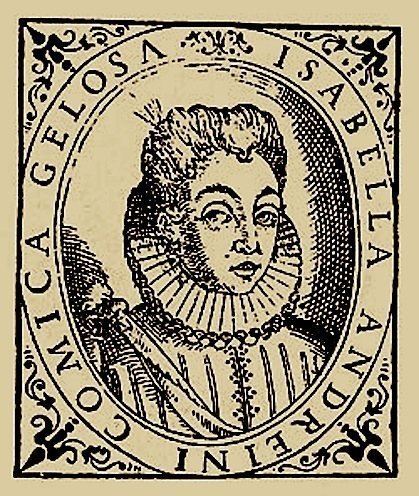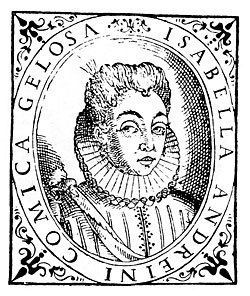Name Isabella Andreini Role Actress | ||
 | ||
Books La Mirtilla, Selected poems of Isabella Andreini | ||
Isabella andreini and the intenti academy of pavia
Isabella Andreini (Padua, 1562 – 10 June 1604), also known as Isabella Da Padova, was an Italian actress and writer. Considered beautiful, elegant, and well educated, she was one of the most famous performers of her time.
Contents
- Isabella andreini and the intenti academy of pavia
- Amorous debate on arms and letters by isabella andreini 1617 with italian subtitles
- Life
- La Pazzia dIsabella
- Literary works
- Publications
- Legacy
- References

Isabella Andreini was a member of the Compagnia dei Comici Gelosi, an important touring theatre company that performed for the highest social circles of Italy and France. Famous in her time, and ever distinguished alike for her acting and her character, the role of Isabella of the commedia dell'arte, was named after her.

Amorous debate on arms and letters by isabella andreini 1617 with italian subtitles
Life

Isabella Andreini was born Isabella Canali in Padua, to Venetian parents.

Although her family was poor, Isabella received a complete classical education. She was very interested in literary culture and became fluent in several languages which she put to use in her La Pazzia d'Isabella (The Divine Madness of Isabella).

In 1576, at age fourteen, Isabella Andreini was hired by the troupe of Flaminio Scala, the Compagnia dei Comici Gelosi. The Gelosi was a well-established theatre company that performed both scripted and unscripted Commedia dell'arte. The Gelosi were patronized by the aristocracy of northern Italy, usually performing for the gentry of Italy and France. Henry III of France was fond of the troupe, and Isabella performed for him in those very early years.
From the beginning, Isabella particularly performed the role of the enamored woman, the prima donna innamorata, and she liked to improvise so the traditional character was less dull and more savvy. She began to improvise and eventually shaped the art form into one of comedic bits and spontaneity. She was one of the women who introduced, developed, and excelled at improvisation She was daring and memorable, sometimes taking off or tearing her clothes onstage. Additionally, Isabella was recognized for her flexibility, an important skill for all commedia dell'arte characters, regardless of sex. Isabella Andreini used her need to play the power dynamics for comedy in her characters. She recognized the importance of her status as the leading actress in a brand new profession. Isabella worked with the Gelosi until her death.
In 1578 Isabella Andreini met and married Francesco Andreini, and non-traditionally took his last name, who would become the director of the Gelosi (1589). Isabella became both the leading lady and an important voice within the Gelosi company. Together with her husband she managed the troupe's activities and she negotiated with possible patrons.
Isabella bore seven children, three boys and four girls, while touring in the Gelosi. She was a dedicated mother. While her firstborn son, Giambattista, continued the theatrical tradition, all her other children were raised by the aristocracy of Mantua to become clergy in Italian monasteries, except one son who became a guard of a duke. She was very strong in her motherhood and her role as wife to Francesco Andreini.
In 1589, Isabella Andreini performed her comic work La Pazzia d'Isabella (Isabella's madness) for the Florentine court during the wedding of Ferdinando I de' Medici and Christina of Lorraine, and the details of the mostly improvised play have endured until modern times. Fluent in several languages, she was renowned for her intellectual presentation and refined presence. In this play she creates madness by using several languages and then imitating dialects of the other characters on stage. She was versatile in her craft and even referred to herself as being capable of playing any male roles. She created the role of Fabrizio, a character used in many of Flaminio Scala's scenarios, where she plays a transvestite pageboy. Isabella was noted as having played three different characters in one scenario, showcasing her improvisation skills and her talent.
In 1599, Isabella Andreini performed before Henry IV, King of France, and his wife Maria de Medici.
Isabella performed at least once for two other troupes: the Confidenti of the Duke of Mantua in 1589, and the Uniti in 1601.
In 1602, Isabella toured northern Italy, and in 1603 she performed again for Henry IV, Marie de' Medici and a local audience at Fontainebleau and Paris. This would be her last tour, because early in 1604 she died near Lyon, on her way back to Italy, when she miscarried her eighth child at age 42. After her state funeral, memorial coins were struck in her honour with one side representing her as a powerful Roman ruler, and the other as the fame goddess herself.
The death of Isabella was observed by the people of Lyon, with a public funeral and an engraved medallion of that year which featured Isabella's portrait on one side, and the figure of Fame on the reverse with the words aeterna fama. Although Francesco Andreini dissolved the Gelosi after her death, their son Giambattista Andreini, who was an actor and a playwright, started his own company, the Fedeli, with the original troupe of the Gelosi.
La Pazzia d'Isabella
Isabella Andreini performed her great La Pazzia d'Isabella at the Medici Wedding Gala of 1589 in Florence. The performance begins with Isabella as the prima donna who has fallen into a star-crossed love. She is abducted by another suitor and turns mad in response. She stripped off her clothing and began speaking in tongues and invited all of the guests to join in her show. Isabella then transformed, physically and vocally, into members of her acting company until she has no identity of her own and is forced to drink a magic potion in order to return to her sanity. She then ended the show by speaking on the power of love and its effects on the human race and mind.
Literary works
Beside performing on stage, Isabella Andreini was a recognized intellectual who dedicated much of her time to literature. The themes of her plays were shaded with some notions questioning the situation of the woman in the society of that epoch; she wrote with a masculine voice in her creations that showed her virtue. Indeed, after publishing Mirtilla (1588) she began corresponding with contemporary intellectuals, attending their forums, and -an uncommon achievement for a woman in her era- in 1601 she was integrated into the literary society of the Accademia degli Intenti of Pavia, for which she adopted the nickname of Accesa. In a poetry contest held by the Cardinal Giorgio Cinthio Aldobrandini of Rome, Isabella Andreini attained second place, only behind the Renaissance poet Torquato Tasso. Like the Tasso, both Gabriello Chiabrera and Giambattista Marino have praised her.
Apart from writing plays, Isabella also wrote poetry and corresponded with a great variety of people
Publications
Legacy
She inspired many French poets, notably Isaac du Ryer (d. c. 1631).
Isabella was known and infamous because of her intimacy onstage. She connected with people and used complex characteristics to make her characters realistic and relatable
The commedia dell'arte stock character, Isabella, used by subsequent com media dell'arte troupes, is named in her honor. In particular, this school of theater has studied the posthumous works of Isabella Andreini, Rime, Parte seconda and Fragmenti de alcune scritture.
